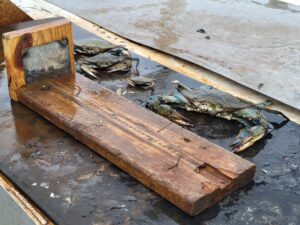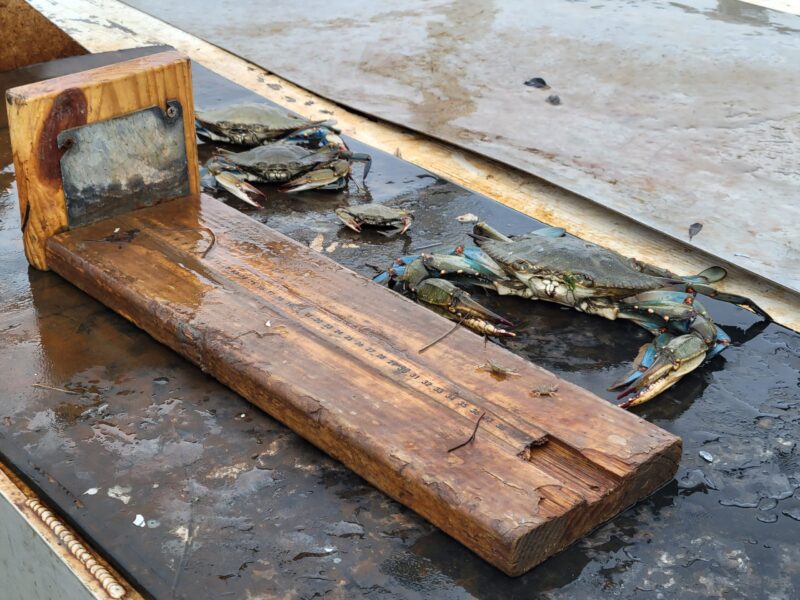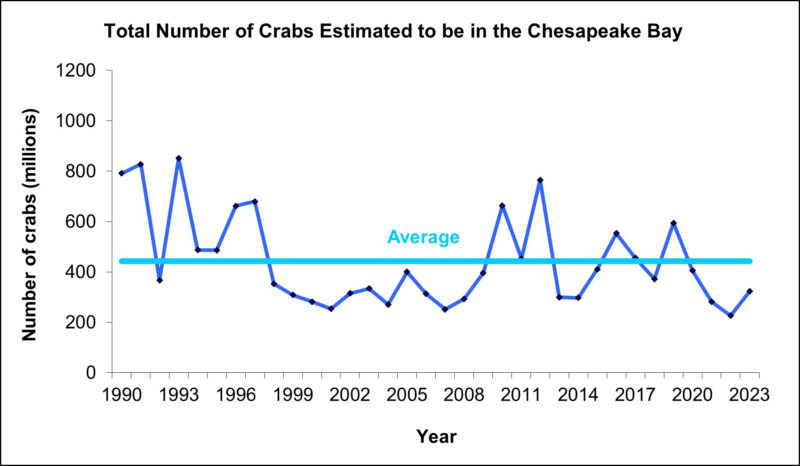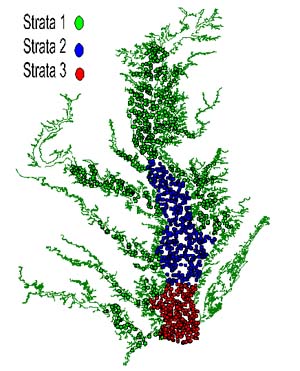
Blue crabs await measurement during the 2024 winter dredge survey. Photo by Joe Zimmermann
At a nondescript spot in the middle of the Choptank River, the Mydra Ann slowed to a crawl.
The crew aboard the crabbing boat, a mix of Maryland Department of Natural Resources (DNR) scientists and commercial watermen, readied the gear. With a thud, the large, steel-toothed dredge met the water of the Choptank, its chain whirring along the center of the boat as the metal bars lined with netting descended to the river bottom.
After a one-minute drag traveling at 3 knots, the crew pulled up the dredge and emptied its contents onto the deck. Among the leaf litter, small rocks, and chunks of ice, small crustaceans shifted groggily—juvenile blue crabs.
“It’s Christmas every day,” said Chris Walstrum, a DNR natural resource biologist. “You don’t know what you’re gonna get.”
Walstrum leads the department’s annual blue crab winter dredge survey, which provides an estimate of the size of the population of Maryland’s state crustacean in the Chesapeake Bay and its tributaries. A coordinated effort between Maryland and Virginia since 1989, this survey helps assess how blue crabs are doing in the Bay and how much of the population is removed by harvest.
Picking through the detritus, Heather Hayden, a DNR biologist, and John Murphy, the first mate of the Mydra Ann, set aside the crabs to be measured and logged. The survey takes place in the winter because crabs are more dormant during the colder months. Though they’re not technically hibernating, the crabs are largely inactive and bury themselves in mud.
The trip to the surface is a temporary awakening for the arthropods. Most only just begin to rouse to the change in temperature and scenery before Walstrum measures them, records their sex, notes any abnormalities (like a missing claw), and casts them back into the chilly waters, where they swim down, disappearing under the surface to resume their slumber.
But the smaller crabs tend to be a bit quicker to adjust. They stretched their tiny claws skyward, pinch-ready.
“They’re a little slower this time of year,” Hayden said. “When you feel them start to reach, you just have to move.”
“They’ll hurt you in the summertime,” said Murphy, who crabs commercially for much of the year. “In the summer, they’re moving and biting all over the place.”
The smallest crabs are the representatives of the latest spawn, known as the young-of-the-year, and are important to the future crab stock of the Bay. Those larger than 2.4 inches across the carapace will grow throughout the summer season—by shedding their exoskeletons every month—and will be able to spawn themselves.
The survey also takes stock of female crabs, or sooks, which are more abundant than male crabs and important to a sustainable population. Easily identified by the Capitol-dome shape of their aprons, female blue crabs mate only once, in their final molt to maturity.
Once the dredge’s pull was accounted for, the team set off to the next location. Roger Morris, the captain of the Mydra Ann and a commercial crabber, entered the GPS coordinates and monitored the depth and temperature of the water on display screens.
The survey samples 1,500 sites, which are randomly assigned with a statistical analysis. Both states split them evenly, so Maryland monitors 750 sites through the course of the winter, hitting around 30 each day.
Morris, who named his boat after his grandmother and daughter, both named Mydra, and his wife Ann, said they try to save the rivers for a windy day and tackle the open Bay when the wind is moderate, but they’re out pretty much every weekday regardless.
“It’s no fair weather game, I’ll tell you that,” Morris said.
Each dredge follows a familiar pattern. After a pull, the team analyzes the crabs. They also clear out the bycatch, which can be anything from sea squirts and small clams to the occasional beer can. The crew returns organic material back into the Bay, while they throw away the litter.
At each site, scientists also collect a water sample to measure salinity and temperature.
In the end, the data collected will help DNR and the Virginia Institute of Marine Science come up with an estimate of the total crab population in the Bay. The population varies from year to year, though recent years have raised concern.
The 2022 survey estimated 227 million crabs, the lowest ever recorded in the survey. In 2023, the population bounced back to 323 million, an encouraging improvement, although scientists urged continued vigilance based on low juvenile abundance.
Predation, water quality issues, and habitat loss likely contribute to diminished blue crab populations. A 2023 study found that invasive blue catfish ate 440 tons of blue crab in the James River in Virginia.
The 2024 blue crab winter dredge survey results won’t be released until May. After completing the 750 sites, the team returns to high density sites and pulls again there, to make note of mortality. By comparing the number there at the first and second pull, they can get a sense of how intense the winter was for the crabs.
Despite the crew’s 45 days on the water through the coldest weather of the year, there was a light mood on the boat. Between pulls, the team joked around with each other and played guessing games at the number of crabs that day or the number of cars leaving Tilghman Island that morning.
Walstrum stays positive about Maryland’s state crustacean too.
“They’re resilient; you can’t look at one year to determine how they’re doing,” he said. “There have been some noticeable drops, but we have to keep on the up.”
By Joe Zimmermann, science writer with the Maryland Department of Natural Resources.

Blue crabs await measurement during the 2024 winter dredge survey. Photo by Joe Zimmermann

The results of the winter dredge survey from 1990 to 2023. Estimates of blue crabs have been below average for the past four years, though fluctuations are common over time.

For the survey, the Bay is divided into three strata, with each assigned a number of sites proportional to its area.


